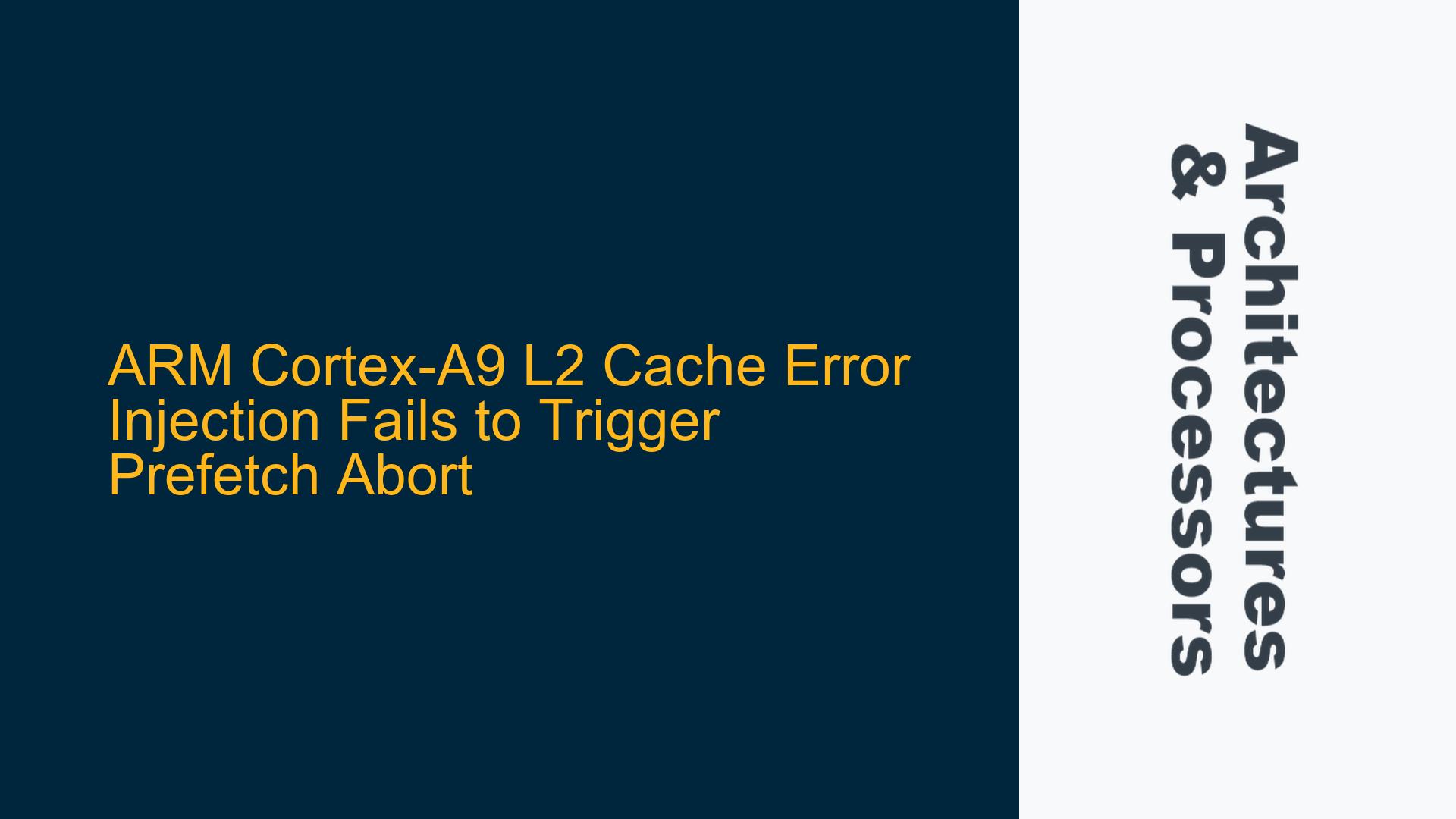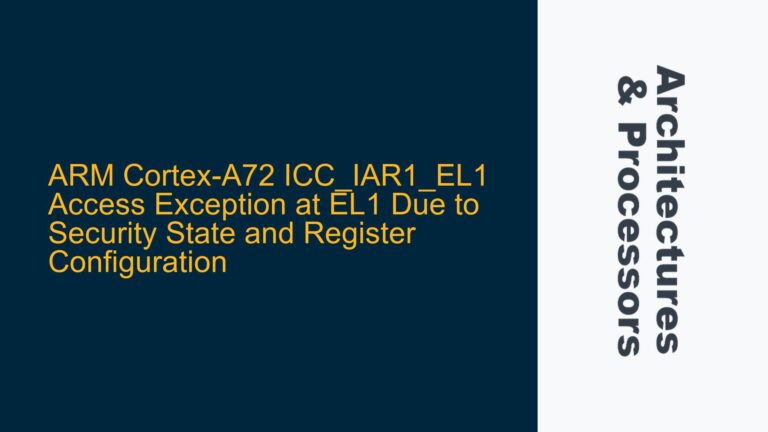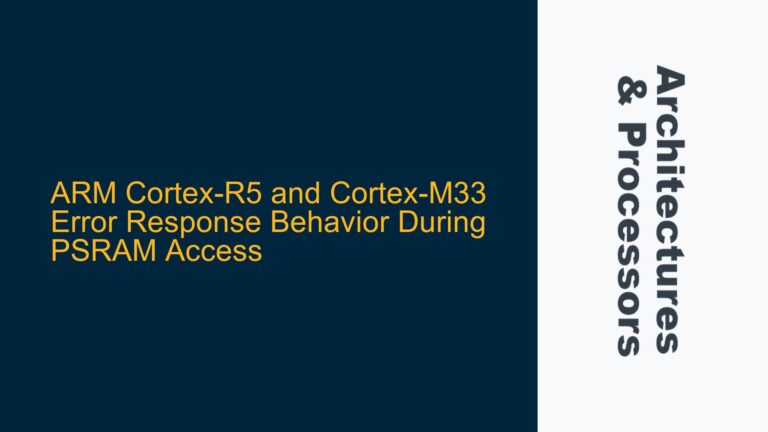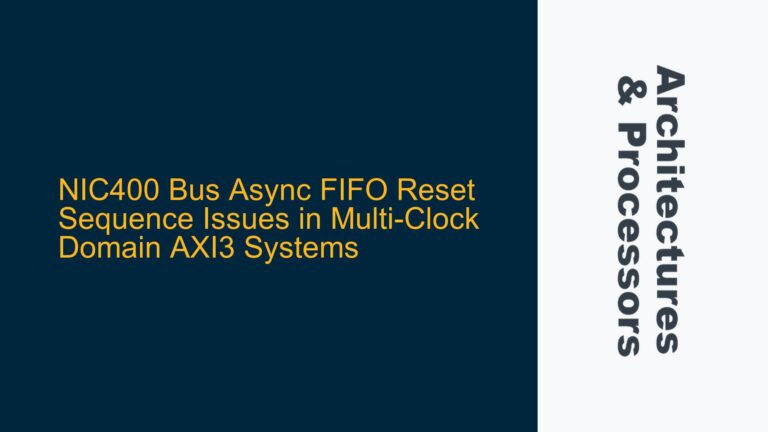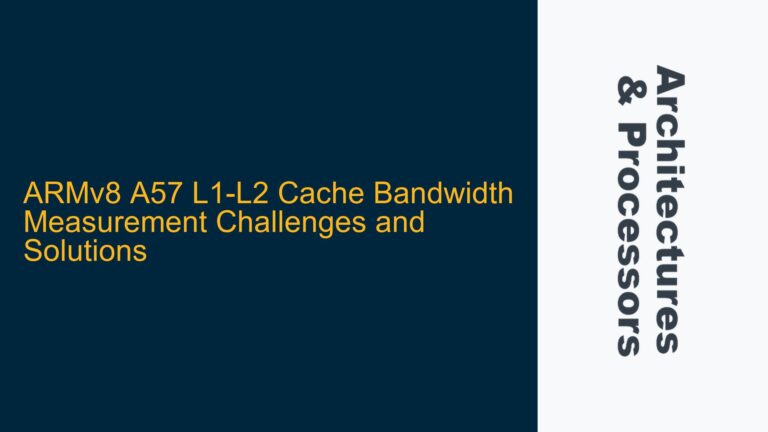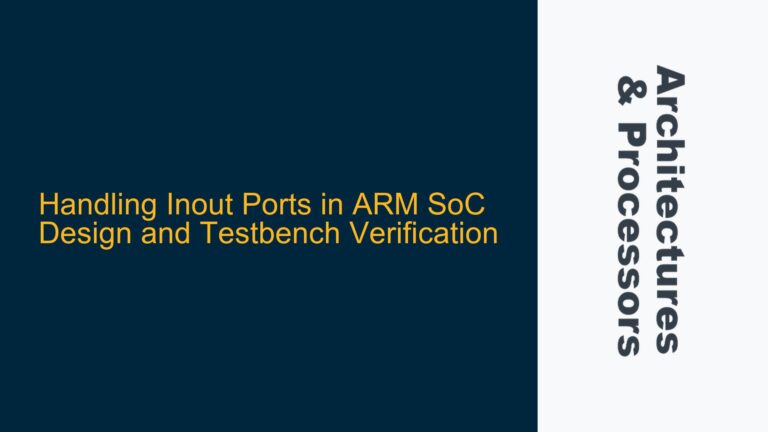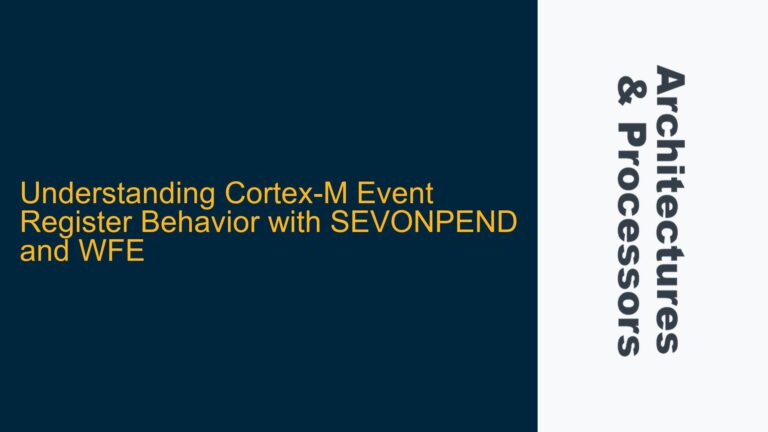ARM Cortex-A9 L2 Cache Parity Error Injection and Prefetch Abort Mechanism
The ARM Cortex-A9 processor, a dual-core implementation commonly used in embedded systems, features a shared L2 cache that serves both instruction and data pipelines. A critical aspect of system reliability testing involves injecting errors into the cache to verify fault tolerance mechanisms, such as triggering a Prefetch Abort when corrupted instructions are fetched. However, in this scenario, the expected Prefetch Abort is not occurring despite deliberate corruption of instructions in the L2 cache. This issue is rooted in the interaction between the cache hierarchy, memory attributes, and the Point of Unification (PoU) in the ARM architecture.
The Cortex-A9 employs a unified L2 cache, meaning it stores both instructions and data. When a function is executed, its instructions are loaded into the L2 cache. By modifying the cache contents after disabling parity checking, the expectation is that a subsequent fetch of the corrupted instruction would trigger a parity error and result in a Prefetch Abort. However, the absence of this expected behavior suggests a misalignment in the cache coherency model, memory attribute configuration, or the PoU implementation.
Memory Attribute Configuration and Cache Coherency at the Point of Unification
The Point of Unification (PoU) is a critical concept in ARM architectures, representing the level in the memory hierarchy where the instruction and data caches are guaranteed to see the same copy of a memory location. In the Cortex-A9, the PoU is typically the L2 cache, as indicated by the Level of Unification Uniprocessor (LoUU) value of 3b’001 in the Cache Level ID Register. This means that cache maintenance operations targeting the PoU must ensure coherency between the L1 and L2 caches.
The memory attributes configured in the Memory Management Unit (MMU) translation tables play a significant role in determining how cache operations are handled. In this case, the DDR memory pages are configured as non-cacheable by default, while the specific region containing the target function is mapped as inner non-cacheable and outer cacheable. This configuration implies that the L1 cache does not store the instructions, but the L2 cache does. However, the outer cacheable attribute allows the L2 cache to retain the instructions, which are then susceptible to corruption during the error injection sequence.
The failure to trigger a Prefetch Abort suggests that the modified cache lines in the L2 cache are not being invalidated or synchronized correctly with the instruction pipeline. This could be due to the omission of necessary cache maintenance operations, such as Data Synchronization Barriers (DSBs) or cache invalidation instructions, which ensure that the instruction pipeline fetches the updated (corrupted) instructions from the L2 cache.
Implementing Cache Maintenance Operations and Synchronization Barriers
To address the issue, a systematic approach involving cache maintenance operations and synchronization barriers must be implemented. The following steps outline the necessary actions to ensure that the L2 cache corruption is correctly propagated to the instruction pipeline, triggering the expected Prefetch Abort.
First, after writing the fixed pattern (e.g., 0x5A5A5A5A) to the cache lines in the L2 cache, a Data Synchronization Barrier (DSB) must be executed. The DSB ensures that all memory accesses, including cache writes, are completed before proceeding to the next instruction. This is crucial to guarantee that the corrupted data is fully written to the L2 cache before the instruction pipeline attempts to fetch it.
Next, a cache invalidation operation targeting the PoU must be performed. The ARM architecture provides the DCIMVAC (Data Cache Invalidate by Modified Virtual Address to PoU) instruction for this purpose. This instruction invalidates the specified cache lines in the L1 and L2 caches, ensuring that the instruction pipeline fetches the updated (corrupted) instructions from the L2 cache. The DCIMVAC instruction must be executed for each cache line corresponding to the target function’s memory region.
Additionally, the ISB (Instruction Synchronization Barrier) instruction should be used after the cache invalidation operation. The ISB ensures that the instruction pipeline is flushed and refetches instructions from the L2 cache, thereby ensuring that the corrupted instructions are executed. This step is critical to trigger the Prefetch Abort, as it forces the instruction pipeline to reload the modified cache lines.
Finally, the L2 cache parity checking should be re-enabled before executing the target function. This ensures that the parity error detection mechanism is active when the corrupted instructions are fetched, resulting in the expected Prefetch Abort.
By following these steps, the L2 cache corruption will be correctly propagated to the instruction pipeline, triggering the Prefetch Abort as intended. This approach addresses the underlying issues related to cache coherency, memory attribute configuration, and the PoU, ensuring that the error injection mechanism functions as expected in the ARM Cortex-A9 processor.
Detailed Explanation of Cache Maintenance and Synchronization Operations
To further clarify the cache maintenance and synchronization operations, let’s delve into the specifics of each instruction and its role in the error injection process.
Data Synchronization Barrier (DSB)
The DSB instruction ensures that all memory accesses, including cache writes, are completed before the processor proceeds to the next instruction. In the context of error injection, the DSB is used after writing the fixed pattern to the L2 cache lines. This ensures that the corrupted data is fully written to the L2 cache before any subsequent instructions are executed. Without the DSB, there is a risk that the instruction pipeline could fetch the original (uncorrupted) instructions from the L2 cache, bypassing the intended corruption.
Data Cache Invalidate by Modified Virtual Address to PoU (DCIMVAC)
The DCIMVAC instruction invalidates the specified cache lines in both the L1 and L2 caches, ensuring that the instruction pipeline fetches the updated (corrupted) instructions from the L2 cache. This instruction is critical to maintaining cache coherency at the PoU, as it ensures that the L1 cache does not retain stale copies of the instructions. The DCIMVAC instruction must be executed for each cache line corresponding to the target function’s memory region, ensuring that all relevant cache lines are invalidated.
Instruction Synchronization Barrier (ISB)
The ISB instruction flushes the instruction pipeline and ensures that subsequent instructions are fetched from the L2 cache. In the context of error injection, the ISB is used after the cache invalidation operation to ensure that the instruction pipeline refetches the corrupted instructions from the L2 cache. This step is crucial to trigger the Prefetch Abort, as it forces the instruction pipeline to reload the modified cache lines, ensuring that the corrupted instructions are executed.
Enabling L2 Cache Parity Checking
After performing the cache maintenance and synchronization operations, the L2 cache parity checking must be re-enabled before executing the target function. This ensures that the parity error detection mechanism is active when the corrupted instructions are fetched, resulting in the expected Prefetch Abort. The parity checking mechanism detects the corrupted data in the L2 cache and triggers the Prefetch Abort, signaling the presence of the error.
Summary of Key Concepts and Operations
To summarize, the failure to trigger a Prefetch Abort in the ARM Cortex-A9 processor during L2 cache error injection is primarily due to the omission of critical cache maintenance and synchronization operations. The following table outlines the key concepts and operations involved in resolving this issue:
| Concept/Operation | Description | Purpose |
|---|---|---|
| Point of Unification (PoU) | Level in the memory hierarchy where instruction and data caches are coherent | Ensures cache coherency between L1 and L2 caches |
| Data Synchronization Barrier (DSB) | Ensures completion of all memory accesses before proceeding | Guarantees that cache writes are fully completed |
| DCIMVAC Instruction | Invalidates cache lines in L1 and L2 caches to PoU | Ensures instruction pipeline fetches updated (corrupted) instructions |
| Instruction Synchronization Barrier (ISB) | Flushes the instruction pipeline and refetches instructions | Ensures corrupted instructions are executed |
| L2 Cache Parity Checking | Detects parity errors in the L2 cache | Triggers Prefetch Abort when corrupted instructions are fetched |
By implementing these cache maintenance and synchronization operations, the L2 cache corruption is correctly propagated to the instruction pipeline, triggering the expected Prefetch Abort. This approach ensures that the error injection mechanism functions as intended, validating the fault tolerance mechanisms of the ARM Cortex-A9 processor.
Conclusion
The ARM Cortex-A9 processor’s L2 cache error injection mechanism requires careful consideration of cache coherency, memory attribute configuration, and the Point of Unification. By addressing these factors and implementing the necessary cache maintenance and synchronization operations, the expected Prefetch Abort can be reliably triggered. This ensures the robustness and reliability of the system, particularly in critical applications such as satellite computers where fault tolerance is paramount.
